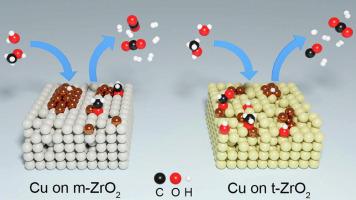Journal of Catalysis ( IF 6.5 ) Pub Date : 2020-09-25 , DOI: 10.1016/j.jcat.2020.09.018 Kevin Ploner , Maximilian Watschinger , Parastoo Delir Kheyrollahi Nezhad , Thomas Götsch , Lukas Schlicker , Eva-Maria Köck , Aleksander Gurlo , Albert Gili , Andrew Doran , Lei Zhang , Nicolas Köwitsch , Marc Armbrüster , Stefan Vanicek , Wolfgang Wallisch , Christoph Thurner , Bernhard Klötzer , Simon Penner

|
We assessed the catalytic properties of the Cu/ZrO2 interface in methanol and formaldehyde steam reforming (MSR and FSR) on powder catalysts by using a comparative approach with respect to the influence of the ZrO2 polymorph support structure (monoclinic (m-)ZrO2 vs. tetragonal (t-)ZrO2), its synthesis routine and the choice of the precursor material on the CO2 selectivity. Our studies reveal that ZrO2 exhibits a pronounced versatility as a support material and its catalytic properties depend most strongly on its surface properties governed by its synthesis, especially by the choice of the Zr precursor. The way of combining the support with copper introduces an additional layer of complexity, but its influence on the MSR performance is limited to a modification of the conditions provided by the ZrO2 support. Exploiting the comparative approach regarding the Cu-ZrO2 catalysts in FSR and MSR – including the pure support materials – in combination with in situ Fourier transform infrared (FT-IR) spectroscopy shows that the CO observed in MSR on Cu/m-ZrO2 can be attributed to a spillover of formaldehyde to the support. Side reactions of m-ZrO2 are suppressed at lower temperatures due to its lack of highly reactive sites, resulting in a CO2-selective MSR performance. In Cu/t-ZrO2, however, the amount of CO is higher and a combination of a formaldehyde spillover to the support and a Cu-ZrO2 phase boundary yielding CO leads to the lower CO2 selectivity of these samples. An elevated number of defects and reactive Lewis acidic and Brønsted basic centers of t-ZrO2 explains this increased activity towards side reactions in contrast to Cu/m-ZrO2 catalysts.
中文翻译:

通过原位和操作研究机制了解Cu / ZrO 2催化剂的甲醇甲醇催化重整反应的机理
我们通过比较方法对ZrO 2多晶型载体结构(单斜晶系(m-)ZrO的影响)评估了粉末催化剂上甲醇和甲醛蒸汽重整(MSR和FSR)中Cu / ZrO 2界面的催化性能。2对四方(t-)ZrO 2),其合成程序以及对CO 2选择性的选择。我们的研究表明ZrO 2 作为载体材料,它具有明显的多功能性,并且其催化性能在很大程度上取决于其合成,尤其是Zr前体的选择所决定的表面性能。载体与铜结合的方式引入了额外的复杂性,但是其对MSR性能的影响仅限于ZrO 2载体所提供条件的修改。利用FSR和MSR中的Cu-ZrO 2催化剂(包括纯载体材料)的比较方法与原位傅里叶变换红外光谱(FT-IR)结合使用,表明MSR在Cu / m-ZrO 2上观察到的CO可以归因于甲醛向载体的溢出。m-ZrO 2的副反应由于缺乏高反应性位点而在较低的温度下得到抑制,从而产生了CO 2选择性MSR性能。但是,在Cu / t-ZrO 2中,CO的量较高,并且甲醛溢出到载体上和Cu-ZrO 2相界产生CO的组合导致这些样品的较低的CO 2选择性。缺陷数量的增加和t-ZrO 2的反应性路易斯酸性和布朗斯台德碱性中心说明了与Cu / m-ZrO 2催化剂相比,这种增加的副反应活性。











































 京公网安备 11010802027423号
京公网安备 11010802027423号